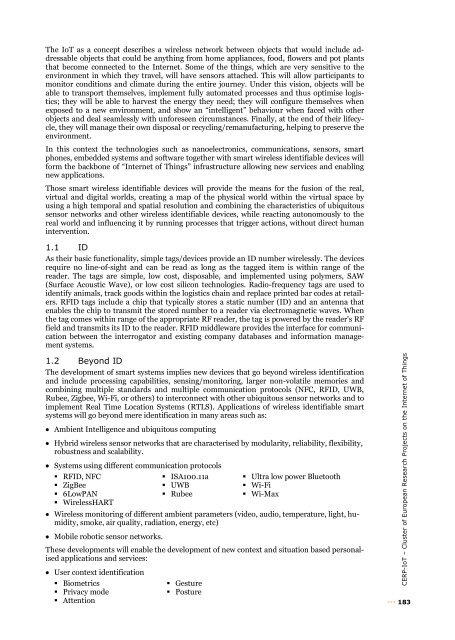Vision and Challenges for Realising the Internet of Things
Vision and Challenges for Realising the Internet of Things
Vision and Challenges for Realising the Internet of Things
You also want an ePaper? Increase the reach of your titles
YUMPU automatically turns print PDFs into web optimized ePapers that Google loves.
The IoT as a concept describes a wireless network between objects that would include addressable<br />
objects that could be anything from home appliances, food, flowers <strong>and</strong> pot plants<br />
that become connected to <strong>the</strong> <strong>Internet</strong>. Some <strong>of</strong> <strong>the</strong> things, which are very sensitive to <strong>the</strong><br />
environment in which <strong>the</strong>y travel, will have sensors attached. This will allow participants to<br />
monitor conditions <strong>and</strong> climate during <strong>the</strong> entire journey. Under this vision, objects will be<br />
able to transport <strong>the</strong>mselves, implement fully automated processes <strong>and</strong> thus optimise logistics;<br />
<strong>the</strong>y will be able to harvest <strong>the</strong> energy <strong>the</strong>y need; <strong>the</strong>y will configure <strong>the</strong>mselves when<br />
exposed to a new environment, <strong>and</strong> show an “intelligent” behaviour when faced with o<strong>the</strong>r<br />
objects <strong>and</strong> deal seamlessly with un<strong>for</strong>eseen circumstances. Finally, at <strong>the</strong> end <strong>of</strong> <strong>the</strong>ir lifecycle,<br />
<strong>the</strong>y will manage <strong>the</strong>ir own disposal or recycling/remanufacturing, helping to preserve <strong>the</strong><br />
environment.<br />
In this context <strong>the</strong> technologies such as nanoelectronics, communications, sensors, smart<br />
phones, embedded systems <strong>and</strong> s<strong>of</strong>tware toge<strong>the</strong>r with smart wireless identifiable devices will<br />
<strong>for</strong>m <strong>the</strong> backbone <strong>of</strong> “<strong>Internet</strong> <strong>of</strong> <strong>Things</strong>” infrastructure allowing new services <strong>and</strong> enabling<br />
new applications.<br />
Those smart wireless identifiable devices will provide <strong>the</strong> means <strong>for</strong> <strong>the</strong> fusion <strong>of</strong> <strong>the</strong> real,<br />
virtual <strong>and</strong> digital worlds, creating a map <strong>of</strong> <strong>the</strong> physical world within <strong>the</strong> virtual space by<br />
using a high temporal <strong>and</strong> spatial resolution <strong>and</strong> combining <strong>the</strong> characteristics <strong>of</strong> ubiquitous<br />
sensor networks <strong>and</strong> o<strong>the</strong>r wireless identifiable devices, while reacting autonomously to <strong>the</strong><br />
real world <strong>and</strong> influencing it by running processes that trigger actions, without direct human<br />
intervention.<br />
1.1 ID<br />
As <strong>the</strong>ir basic functionality, simple tags/devices provide an ID number wirelessly. The devices<br />
require no line-<strong>of</strong>-sight <strong>and</strong> can be read as long as <strong>the</strong> tagged item is within range <strong>of</strong> <strong>the</strong><br />
reader. The tags are simple, low cost, disposable, <strong>and</strong> implemented using polymers, SAW<br />
(Surface Acoustic Wave), or low cost silicon technologies. Radio-frequency tags are used to<br />
identify animals, track goods within <strong>the</strong> logistics chain <strong>and</strong> replace printed bar codes at retailers.<br />
RFID tags include a chip that typically stores a static number (ID) <strong>and</strong> an antenna that<br />
enables <strong>the</strong> chip to transmit <strong>the</strong> stored number to a reader via electromagnetic waves. When<br />
<strong>the</strong> tag comes within range <strong>of</strong> <strong>the</strong> appropriate RF reader, <strong>the</strong> tag is powered by <strong>the</strong> reader's RF<br />
field <strong>and</strong> transmits its ID to <strong>the</strong> reader. RFID middleware provides <strong>the</strong> interface <strong>for</strong> communication<br />
between <strong>the</strong> interrogator <strong>and</strong> existing company databases <strong>and</strong> in<strong>for</strong>mation management<br />
systems.<br />
1.2 Beyond ID<br />
The development <strong>of</strong> smart systems implies new devices that go beyond wireless identification<br />
<strong>and</strong> include processing capabilities, sensing/monitoring, larger non-volatile memories <strong>and</strong><br />
combining multiple st<strong>and</strong>ards <strong>and</strong> multiple communication protocols (NFC, RFID, UWB,<br />
Rubee, Zigbee, Wi-Fi, or o<strong>the</strong>rs) to interconnect with o<strong>the</strong>r ubiquitous sensor networks <strong>and</strong> to<br />
implement Real Time Location Systems (RTLS). Applications <strong>of</strong> wireless identifiable smart<br />
systems will go beyond mere identification in many areas such as:<br />
Ambient Intelligence <strong>and</strong> ubiquitous computing<br />
Hybrid wireless sensor networks that are characterised by modularity, reliability, flexibility,<br />
robustness <strong>and</strong> scalability.<br />
Systems using different communication protocols<br />
RFID, NFC<br />
ZigBee<br />
6LowPAN<br />
WirelessHART<br />
ISA100.11a<br />
UWB<br />
Rubee<br />
Ultra low power Bluetooth<br />
Wi-Fi<br />
Wi-Max<br />
Wireless monitoring <strong>of</strong> different ambient parameters (video, audio, temperature, light, humidity,<br />
smoke, air quality, radiation, energy, etc)<br />
Mobile robotic sensor networks.<br />
These developments will enable <strong>the</strong> development <strong>of</strong> new context <strong>and</strong> situation based personalised<br />
applications <strong>and</strong> services:<br />
User context identification<br />
Biometrics<br />
Privacy mode<br />
Attention<br />
Gesture<br />
Posture<br />
CERP-IoT – Cluster <strong>of</strong> European Research Projects on <strong>the</strong> <strong>Internet</strong> <strong>of</strong> <strong>Things</strong><br />
183
















